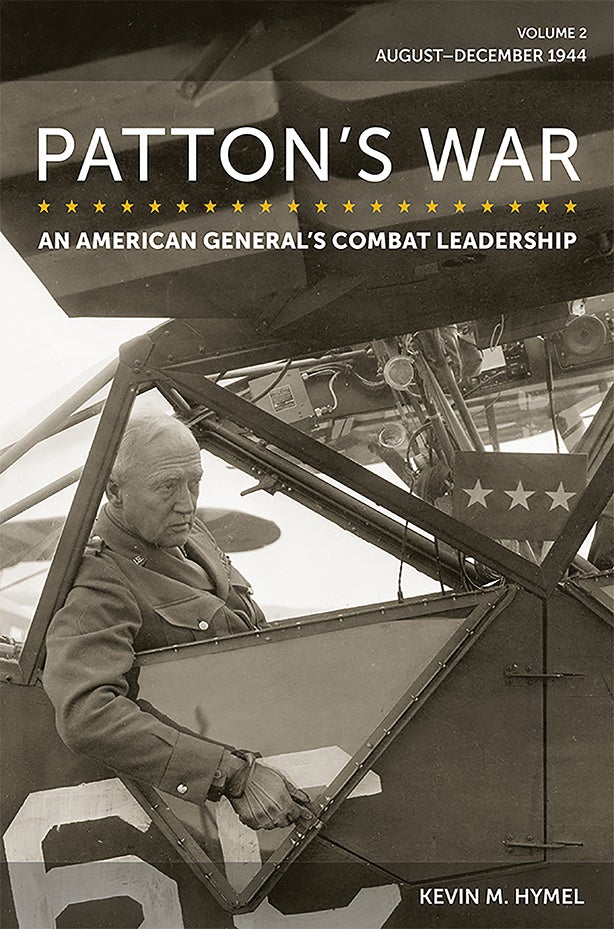Patton Proves Himself During World War II

Patton’s War: An American General’s Combat Leadership, Volume 2, August–December 1944. Kevin Hymel. University of Missouri Press. 480 pages. $39.95
By Col. Cole Kingseed, U.S. Army retired
Nearly 80 years after Allied forces invaded France on D-Day, June 6, 1944, Gen. George Patton Jr. continues to fascinate military historians and students of World War II. In the second volume of his acclaimed Patton’s War trilogy, Kevin Hymel provides a more comprehensive understanding of his subject’s leadership from the time Third U.S. Army became operational in Normandy, France, on Aug. 1, 1944, through the Battle of the Bulge.
The author of four books, including Patton’s Photographs: War as He Saw It and Patton’s War: An American General’s Combat Leadership, Volume 1, November 1942–July 1944, Hymel is a contract historian at Arlington National Cemetery and a tour historian at Stephen Ambrose Historical Tours, where he has led multiple tours in “Patton’s Footsteps.”
This current volume, Patton’s War: An American General’s Combat Leadership, Volume 2, August–December 1944, is radically different from the first volume, as Hymel discovered that Patton’s transcribed diary was highly embellished from the general’s handwritten notes.
Also, between Nov. 8, 1942, and July 31, 1944, Patton spent only 10 weeks and three days in actual combat. In this volume, there is no break in contact with the enemy. North Africa and Sicily may have witnessed Patton’s evolution from a corps to an army commander, but in the campaign in northwest Europe, Patton matured as the master of the battlefield.
In exploring this transformation, Hymel puts to rest many of the myths surrounding Patton. Contrary to Hollywood legend and Patton’s transcribed diary, written by his wife and two staff officers in 1953, Patton did not predict the German Ardennes counteroffensive in mid-December 1944. Hymel writes, “Throughout late November [1944], Patton believed the Germans were incapable of any kind of major action.” Neither did Gen. Dwight Eisenhower nor Gen. Omar Bradley predict the German onslaught.
Hymel posits that all the “American commanders suffered collective hubris when it came to the Battle of the Bulge.” Only Eisenhower understood the enormity of the German attack and directed Patton to abandon his plan to break free of the Siegfried Line and attack north.
Patton’s sublime moment, Hymel writes, came after the Third Army commander departed a meeting in Verdun, France, with Eisenhower and his commanders shortly after the Battle of the Bulge began. It was one thing for Patton to claim he could pivot his forces and go on the attack; it was another to deliver the goods. Though it took a few additional days to reach the beleaguered garrison of Bastogne, Belgium, the forward elements of Patton’s Third Army liberated the city the day after Christmas of 1944.
Hymel leaves little doubt that he is an admirer of Patton and his way of war. Patton was the only American general to emerge from the Normandy campaign with his reputation enhanced, Hymel writes. From September through November 1944, Patton not only kept his army fully engaged against the enemy, but he also forced the enemy from the Moselle, Seille and Saar rivers in France before the Battle of the Bulge intervened.
And no other commander could have turned an army 90 degrees and conducted such a vigorous attack against the southern shoulder of the enemy penetration in Belgium. In short, the last five months of 1944 witnessed Patton at the height of his powers.
Hymel has demonstrated once again that he is one of Patton’s most distinguished biographers, on par with Martin Blumenson in The Patton Papers and Carlo D’Este in Patton: A Genius for War. Readers will anxiously await the concluding volume of Patton’s War to accurately assess Hymel’s opinion that “World War II was truly his war.”
Col. Cole Kingseed, U.S. Army retired, a former professor of history at the U.S. Military Academy, West Point, New York, is a writer and consultant. He holds a doctorate in history from Ohio State University.
* * *
11th Airborne Fights Across the Pacific

Angels Against the Sun: A WWII Saga of Grunts, Grit, and Brotherhood.
James Fenelon. Regnery History. 528 pages. $34.99
By John McManus
In Angels Against the Sun: A WWII Saga of Grunts, Grit, and Brotherhood, James Fenelon selects an appropriate subject to highlight the U.S. Army’s gritty fight in the Pacific during World War II. The 11th Airborne Division was an elite unit that played a key role in the liberation of the Philippines.
An eclectic mixture of about 8,000 paratroopers and glider-trained soldiers under Maj. Gen. Joseph Swing populated the division. Most of the men were volunteers. Many were colorful, rough-and-ready characters who loved to drink, brawl and carouse. They fit the classic profile of young combat soldiers who excelled in battle but often found trouble outside it. In the Pacific Theater, they developed a well-deserved reputation for midnight requisitioning. Woe to any unit that did not keep a close watch over its food, equipment and other valuables when the 11th Airborne was in the vicinity.
Proud of their reputation for rule-breaking, the rough-hewn men of the division embraced the ironic, tongue-in-cheek nickname of “the Angels.” Less-enamored soldiers from other outfits routinely referred to them as “Ali Baba Swing and the 8,000 Thieves.”
The division deployed to New Guinea in May 1944 where it did some combat patrolling, but its major action took place in the Philippines during the battles of Leyte and Luzon. On Leyte, the troopers fought intimate, close-quarters engagements with Japanese soldiers, well beyond the main lines of Lt. Gen. Walter Krueger’s U.S. Sixth Army.
Braving heat, torrential rain, insects, disease, hunger, privation and thick, jungled, mountainous terrain, the Angels fought for weeks on end without reinforcement or relief. For the most part, they were supplied by air, strikingly similar to the more famous Merrill’s Marauders in Burma, now Myanmar. Over the course of the Leyte campaign, C-47 transport aircraft of the 11th Air Cargo Resupply Squadron dropped a staggering 388,570 pounds of materiel to the 11th Airborne.
On Luzon, the division only added to its distinguished combat record. The Angels participated in the liberation of Manila, made a combat jump on Tagaytay Ridge and liberated starving Allied civilians at the Los Banos internment camp through a wonderfully planned coup de main operation that featured an airborne drop to seize the camp buildings and waterborne amtracs to evacuate the emaciated internees to the safety of American lines.
The troopers also were deeply enmeshed in the unglamorous hilltop-to-hilltop slog that characterized the fighting on Luzon well into the summer of 1945. Then, after the Japanese surrender, the 11th Airborne playing a leading role in the initial occupation of Japan.
Fenelon more than does justice to the fascinating story of this remarkable division. The book is beautifully researched and well-written. Seldom does one encounter such a pleasing blend of scholarship and artistry. Chapters relate the chronological story of the division’s experiences, from the perspective of privates and generals alike. Fenelon paints vivid portraits of key leaders such as the swashbuckling division commander Swing, who often clashed with his troopers and his staff, but proved himself an effective senior leader, and Col. Orin Haugen, the chain-smoking, hard-charging commander of the 511th Parachute Infantry Regiment, who was mortally wounded by shell fragments during fighting for Manila.
Fenelon is a former Army paratrooper himself, and a graduate of both Jumpmaster and Pathfinder schools, so he enjoys a keen understanding of the airborne world that few historians can match. Angels Against the Sun is an outstanding book, and one of the best division histories I have read. I highly recommend it.
John McManus is Curators’ Distinguished Professor of U.S. Military History at Missouri University of Science and Technology. He is the author of 15 books, including To the End of the Earth: The US Army and the Downfall of Japan, 1945. He holds a doctorate in history from the University of Tennessee.
* * *
Insights Into Early Days of Peacekeeping Experiences

Yanks in Blue Berets: American UN Peacekeepers in the Middle East. L. Scott Lingamfelter. University Press of Kentucky (An AUSA Title). 320 pages. $34.95
By Gen. Wesley Clark, U.S. Army retired
Retired Col. L. Scott Lingamfelter’s Yanks in Blue Berets: American UN Peacekeepers in the Middle East fills a significant void in military writings. Drawn from his experience as a peacekeeper in the U.N. Truce Supervision Organization in 1981, Lingamfelter has captured the essence of a bygone era, but with potentially important lessons for military leaders of today and tomorrow.
Part travelogue, part detailed daily journal, part history and part thoughtful analysis, Lingamfelter paints a vivid picture of a U.S. Army artilleryman assigned to serve as a military observer amid the workings and geopolitical context of this oldest of U.N. peacekeeping organizations. The U.N. Truce Supervision Organization (UNTSO) was grappling with the volatile situation in south Lebanon after Israel’s first foray north in 1978 and before Israel’s major invasion in 1982. Lingamfelter himself was deployed as an unarmed, blue-helmeted observer on an accompanied tour.
Yet UNTSO dispatched him and his fellow American military officers—the “Yanks in blue berets” of the title—around the region, including with the U.N. Interim Force in Lebanon (UNIFIL), an armed force deployed to separate the Israeli and Palestinian forces in south Lebanon after 1978.
The six armed battalions of the UNIFIL, each of a different nation, of uneven competence and capability, came to represent all that has been wrong with U.N. peacekeeping: too broad a mandate, poorly planned, inadequately staffed and without proper weaponry, leadership or authority. Lacking the strategic consent of the warring parties, UNIFIL failed in its mission. Lingamfelter brings this all forward in unforgettable, tragic detail.
He follows his personal experiences with a concise, expert summary of all that followed in the wake of UNIFIL’s failure—Israel’s 1982 invasion of southern Lebanon, the U.S. participation in the Multinational Force and the painful consequences throughout the Middle East.
But UNIFIL’s failure also represents the tragic willingness of “the suits” to throw soldiers into harm’s way without understanding their own responsibilities, as well as the failure of top-level military leaders to convey to civilian authorities the risks and hard military requirements in clear and certain terms.
The administration of U.S. President Bill Clinton also learned these lessons, but only after the Black Hawk Down tragedy in Mogadishu, Somalia, in 1993, then the follow-on fiasco in Haiti when 800 U.S. marshals were turned away by Haitian junta leader Gen. Raoul Cedras. Subsequent U.S. operations in Haiti, Bosnia and Kosovo were fully thought through, resourced and successful militarily and diplomatically. We were, in former Secretary of State Madeleine Albright’s words, the “indispensable power.”
The Cold War era that Lingamfelter describes, and even the post-Cold War era, is gone, and the rules-based international order and the U.N. itself are under far greater challenge today by Russia and China. But soldiers are drawn to the sound of the guns, and for professional experience, situational understanding and diplomatic necessity, the U.S. should anticipate that we will continue at some level to send American service members as observers to potential battlefields and hot spots.
No doubt American forces will again engage and enforce peace. Professionalism is not only about steel on target, but also the broader use of military power to achieve national goals.
Lingamfelter has given us a poignant and useful reminder of duty performed, risks accepted and hard lessons learned from multilateral failure.
Gen. Wesley Clark, U.S. Army retired, is chairman and CEO of Wesley K. Clark & Associates, an international consulting firm based in Little Rock, Arkansas. He served 34 years in the Army, with his last assignment as Supreme Allied Commander, Europe. He graduated first in his class at the U.S. Military Academy, West Point, New York, in 1966 and was a Rhodes scholar.
* * *
Female Reservist Recounts Her Journey Through the Toughest of Army Training

Delete the Adjective: A Soldier’s Adventures in Ranger School. Lisa Jaster. Houndstooth Press. 226 pages. $24.99
By Kayla Williams
In 2013, then-Chairman of the Joint Chiefs of Staff Gen. Martin Dempsey and Secretary of Defense Leon Panetta initiated the process to formally open all military jobs and units to women. Two years later, 19 women were among the 399 candidates who began the first-ever integrated U.S. Army Ranger School class. Delete the Adjective: A Soldier’s Adventures in Ranger School by Lisa Jaster recounts Jaster’s experience as one of the three women who ultimately graduated, leading the way for the now over 100 women who have earned the coveted Ranger tab.
Jaster notes that there are other adjectives beyond “female” that made her an unusual Ranger School student: She was also “old” (at 37, nearly twice the age of the youngest students) and a U.S. Army Reservist. Her book is a compelling argument that those and all other “adjectives are descriptors, not limiters” of what people can accomplish.
Jaster’s book is a fascinating insider view of Ranger School for those of us who have not had the pleasure of attending one of “the Army’s toughest schools,” as the book says. She details the school’s various components: the Ranger Training Assessment Course, Ranger Assessment Phase week and the Darby, Mountain and Swamp phases. She describes not just the grueling physical demands but also the cognitive challenges of land navigation and small-unit tactics, as well as the “socioemotional” elements of working alongside other troops and taking turns as a leader, peer and subordinate.
Jaster also details at length the unique hurdles the first female candidates navigated. This includes the presence of observer/advisers, who “most of the female Ranger hopefuls would have run … out of camp if we could,” she writes. Another was the “media frenzy,” since the “unwanted attention made everything harder on everyone.”
Having to overcome casual sexism from both peers and Ranger instructors who did not want women in Ranger School is a constant theme. Jaster seems to relish the opportunity to prove people wrong by succeeding when they expect her to fail, taking justifiable pride in being prepared, skilled and fit.
Concurrently, her frustration at the common perception that the school changed its standards to accommodate female applicants is palpable: “I can confidently declare the standards did, in fact, change,” she writes. “They got harder, and everyone knew it.”
I particularly appreciate the moments of vulnerability and humanity Jaster shares. Not for a moment does she pretend to be a superhero or a robot. Jaster shares the letter from a West Point classmate that helps inspire her to go out for Ranger School, showing how important personal support can be. She writes movingly about missing her family, which, as a woman, she felt “authorized” to do. And Jaster admits to feeling occasionally hopeless, furious, proud and joyful.
These glimpses of the complex and real human beneath the uniform and behind the adjectives left me rooting hard for her ultimate success after recycling every single phase and spending six months away from her family.
Jaster closes by sharing that Gen. Mark Milley, then-chief of staff of the Army, charged her to “be visible” so people could see her and her success, perhaps helping inspire others.
I finished the book inspired to push myself harder and take bigger risks—though Ranger School is definitively not in my future as a mid-40s civilian.
If you’re looking for motivation that your adjectives, whatever they are, don’t have to hold you back, this is the book for you.
Kayla Williams is a senior policy researcher at the nonprofit, nonpartisan Rand Corp. and is the author of Love My Rifle More Than You: Young and Female in the U.S. Army.

